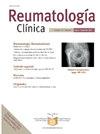Real life treatment in juvenile idiopathic arthritis: Is remission long lasting?
IF 1.3
Q4 RHEUMATOLOGY
引用次数: 0
Abstract
Objectives
Juvenile idiopathic arthritis (JIA) is a chronic inflammatory disease that can cause pediatric disability. Achieving stable remission is the main objective to avoid disability. We evaluated remission survival in a cohort of patients with JIA and analyzed factors that might influence long lasting remission.
Methods
We designed an observational, retrospective and longitudinal study of JIA patients. Remission survival was determined from the first visit in clinical remission to the first flare after remission or the last visit recorded at the end of the study. Stable remission was defined as patients fulfilling the Wallace criteria during 18 months of the Covid pandemic. To compare the role of treatment on stable remission, we divided patients into three groups: without systemic treatment, treated with methotrexate only and treated with biologics.
Results
We included 82 JIA patients, 68.3% of whom were female and the median age of disease onset was 4.49 years old. There were no differences in the remission survival rates between JIA subgroups. Nearly 80% had maintained remission at 3 years and a high proportion of patients (68.3%) were still in remission after 5 years. Fifty-seven patients (69.5%) reached stable remission throughout 18 months of the Covid-19 pandemic. Stable remission was more likely in patients without systemic treatment (47.4%) (p = 0.015).
Conclusions
Remission survival was long-term in real life conditions, with nearly 80% of our patients maintaining stable remission after 3 years. Flares were more frequent in patients treated with methotrexate in monotherapy.
青少年特发性关节炎的现实生活治疗:缓解是持久的吗?
目的:小儿特发性关节炎(JIA)是一种可导致儿童残疾的慢性炎症性疾病。实现稳定的缓解是避免残疾的主要目标。我们评估了一组JIA患者的缓解生存期,并分析了可能影响长期缓解的因素。方法对JIA患者进行观察性、回顾性和纵向研究。从临床缓解的第一次就诊到缓解后的第一次发作或研究结束时记录的最后一次就诊,确定缓解期生存期。稳定缓解被定义为在新冠肺炎大流行的18个月内满足华莱士标准的患者。为了比较治疗对稳定缓解的作用,我们将患者分为三组:不进行全身治疗,仅使用甲氨蝶呤治疗和使用生物制剂治疗。结果纳入82例JIA患者,女性占68.3%,中位发病年龄4.49岁。JIA亚组间的缓解生存率无差异。近80%的患者在3年后保持缓解,5年后仍有很高比例的患者(68.3%)处于缓解状态。57名患者(69.5%)在新冠肺炎大流行的18个月内达到稳定缓解。未接受全身治疗的患者更有可能出现稳定缓解(47.4%)(p = 0.015)。结论:在现实生活条件下,缓解生存期是长期的,近80%的患者在3年后保持稳定的缓解。单用甲氨蝶呤治疗的患者更容易出现耀斑。
本文章由计算机程序翻译,如有差异,请以英文原文为准。
求助全文
约1分钟内获得全文
求助全文
来源期刊

Reumatologia Clinica
RHEUMATOLOGY-
CiteScore
2.40
自引率
6.70%
发文量
105
审稿时长
54 days
期刊介绍:
Una gran revista para cubrir eficazmente las necesidades de conocimientos en una patología de etiología, expresividad clínica y tratamiento tan amplios. Además es La Publicación Oficial de la Sociedad Española de Reumatología y del Colegio Mexicano de Reumatología y está incluida en los más prestigiosos índices de referencia en medicina.
 求助内容:
求助内容: 应助结果提醒方式:
应助结果提醒方式:


